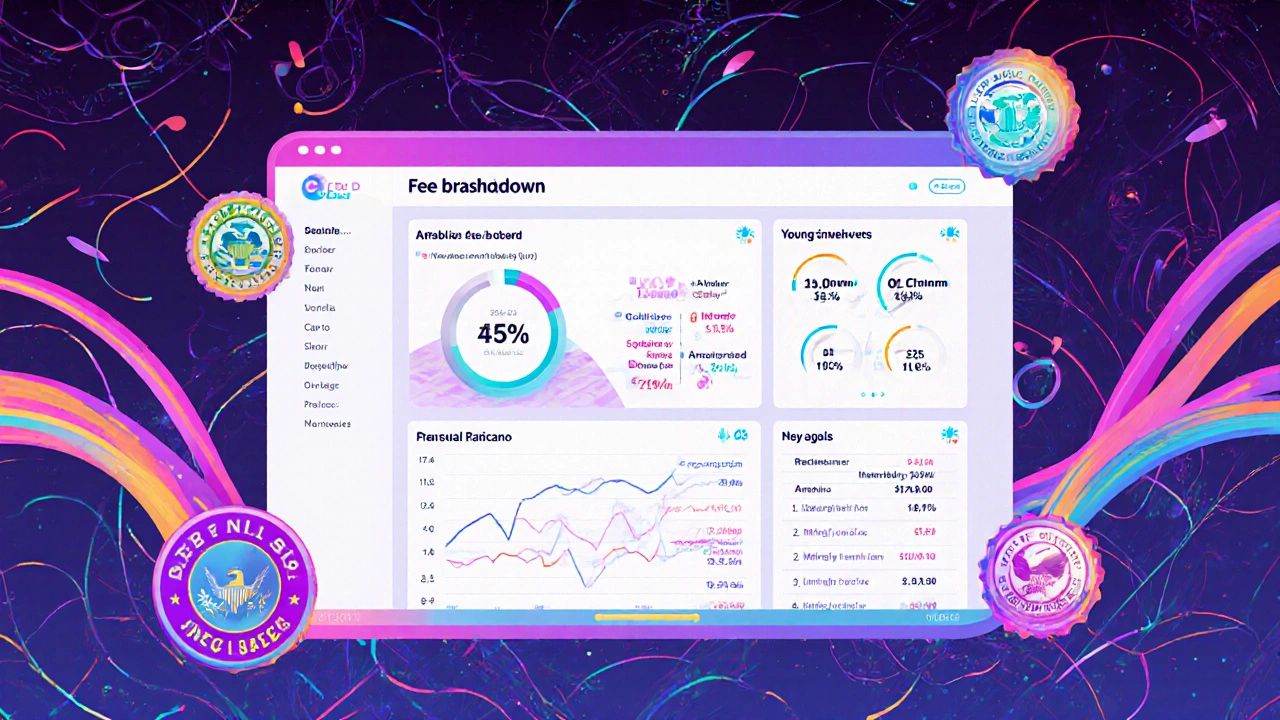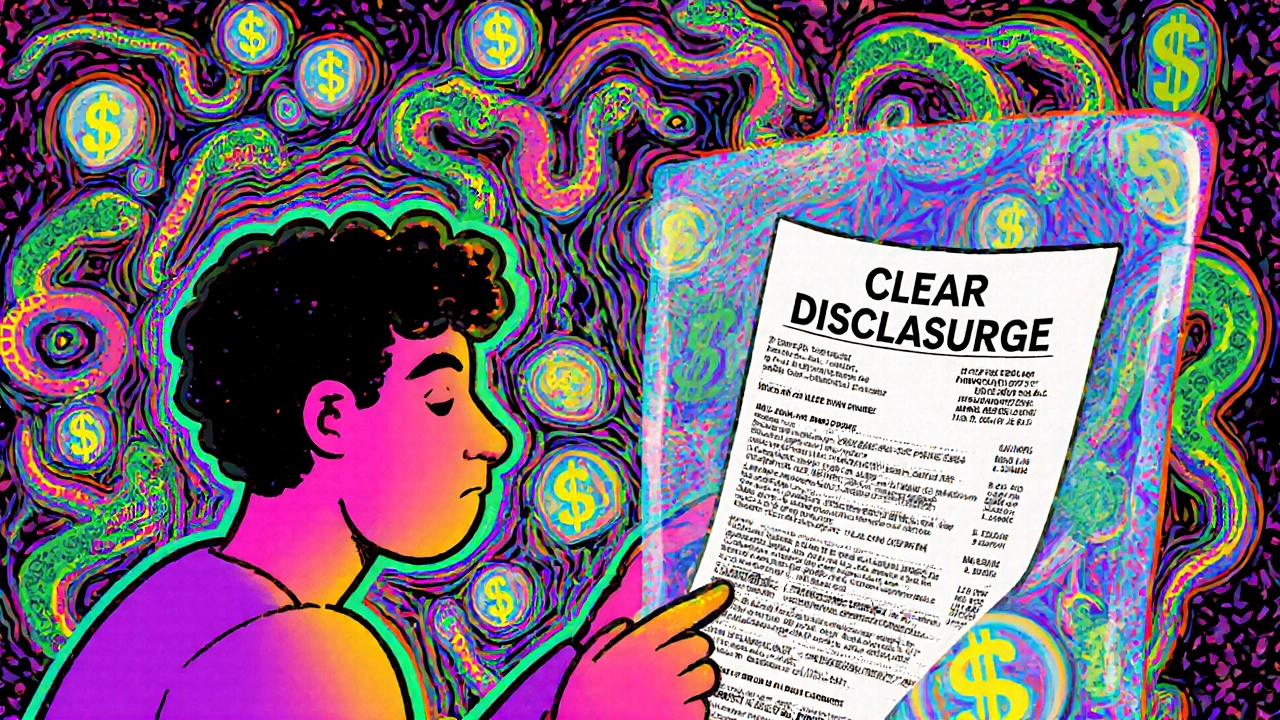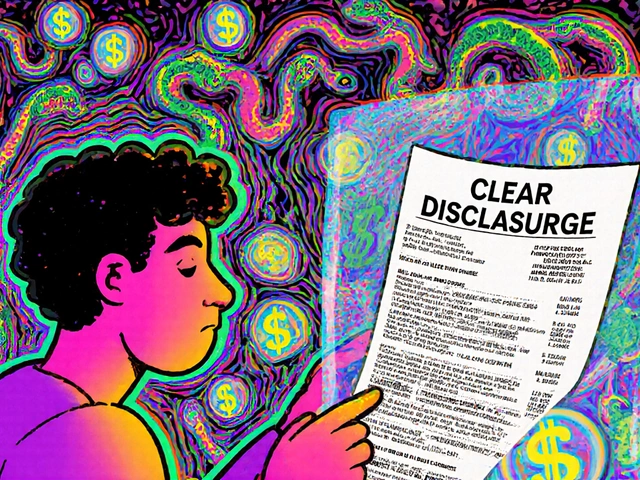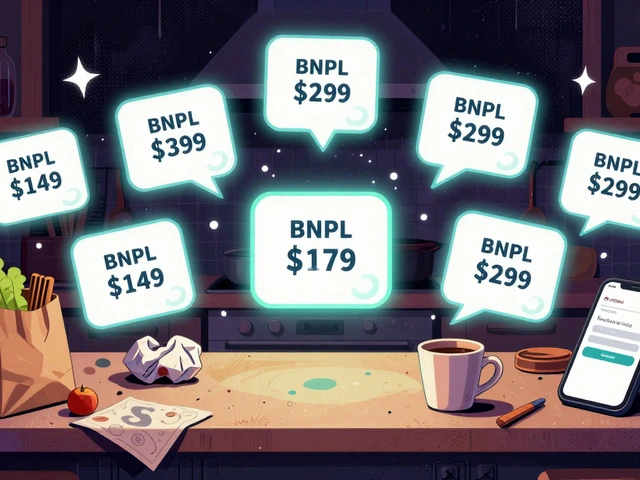Hidden Fee Calculator
Calculate Your Total Financial Cost
Understand what you're really paying by accounting for hidden fees and additional costs
Total Annual Cost: $0.00
Total Cost as % of Principal: 0.00%
Note: The CFPB recommends comparing your total cost to industry averages. Fees above 2-3% of assets are generally considered unreasonable for advisory services.
Hidden fees. Fine print. Confusing terms. If you’ve ever opened a bank statement, investment account, or loan agreement and felt like you needed a degree to understand it, you’re not alone. These aren’t accidents-they’re tactics. Predatory financial practices thrive when people can’t see what they’re really paying. Transparent fees and disclosures aren’t just legal requirements-they’re the first line of defense against exploitation, especially for people who can’t afford to get ripped off.
Why Hidden Fees Are a Form of Theft
Imagine you’re buying a car. The dealer says $25,000. You sign the papers. Later, you find out there’s a $1,200 ‘documentation fee,’ a $750 ‘dealer prep charge,’ and a $300 ‘extended warranty’ you never asked for. You didn’t agree to these. You were never told. That’s not a surprise-it’s a scam. That’s exactly what happens in finance. A mutual fund advertises a 0.5% expense ratio. Sounds cheap. But buried in the 50-page prospectus is a 1.2% trading fee, a 0.8% administrative fee, and a 0.3% performance fee. Your total cost? 2.8%. You didn’t know. You thought you were paying half a percent. That’s not a mistake. It’s designed to confuse. The Consumer Financial Protection Bureau (CFPB) found that in 2022, consumers who got clear fee disclosures filed 37% fewer complaints about mortgages and 29% fewer about credit cards. That’s not luck. That’s proof that when people know what they’re paying, they’re less likely to be taken advantage of.What the Law Actually Requires
The U.S. doesn’t leave this to chance. Laws like the Truth in Lending Act (TILA) and the Investment Advisers Act of 1940 force financial companies to spell out costs in plain language. But it’s not enough to just list fees-you have to make them impossible to miss. For example, if a credit card advertises a 0% APR for 12 months, the law says the fine print about the regular APR after that must be the same size and color as the promo rate. No tiny font. No hidden corner. Same visibility. Same weight. Investment advisers must give you Form ADV Part 2-a client-facing document that breaks down their fees in plain English. It can’t say “fees are based on assets under management.” It must say: “We charge 1.5% of your total investments each year. If you have $100,000, that’s $1,500 annually.” No jargon. No ambiguity. The SEC and NASAA don’t just want disclosure-they want reasonableness. Many states consider fees above 2-3% of assets unreasonable for advisory services. If a firm charges 4% and hides it in a 100-page document, regulators will come knocking. That’s not a gray area. It’s a violation.Where Transparency Still Fails
Even with strong rules, some areas still let people slip through the cracks. Mutual funds are the worst offenders. The expense ratio you see on the website? It doesn’t include trading costs, brokerage fees, or taxes on internal sales. The Department of Labor called this “incomplete cost representation” back in 2016-and it’s still true today. A 2023 study found that 68% of investors felt overwhelmed by fee disclosures. Only 29% could accurately compare total costs across different funds. Why? Because the documents are written by lawyers, not humans. They’re full of cross-references, acronyms, and legalese. One Reddit user found $1,842 in unexpected fees over 18 months by reading their investment agreement line by line. That’s not diligence-that’s a trap. Even when fees are disclosed, they’re often buried. A robo-advisor might say “low fees” on its homepage, but the real cost-$1,200 a year-is hidden in a PDF you have to download and print to read. That’s not transparency. That’s obfuscation.What Works: Real Examples of Clear Disclosure
Some companies get it right. The CFPB’s “Know Before You Owe” mortgage disclosure, launched in 2015, cut shopping time by 42%. Why? Because it showed three things side by side: the monthly payment, the total cost over time, and the APR-all in one page, in plain language. The Federal Reserve tested different formats for mortgage disclosures. Text-only? 72% of people understood the implications. Visual charts showing how minimum payments increased your loan balance? 100% understood. That’s the power of design. A small investment firm in Oregon switched from a 47-page fee document to a one-page summary with icons: a dollar sign for fees, a clock for timing, a warning triangle for risks. Client questions dropped by 60%. Complaints fell to zero. They didn’t change their fees. They changed how they showed them. Even non-financial companies show the power of transparency. EcoFoods, an organic grocery chain, started sharing their marketing budget openly with their team. They didn’t hide costs. They explained them. Result? A 22% increase in customer acquisition. When people understand where money goes, they trust more-and spend more.How to Protect Yourself
You don’t need a finance degree to spot a shady fee. Here’s how to fight back:- Ask for the fee schedule in writing. If they won’t give it to you before you sign, walk away.
- Look for the total cost, not just the monthly rate. A $0 monthly fee on a credit card means nothing if the APR is 29%.
- Compare apples to apples. If you’re comparing investment accounts, ask for the all-in expense ratio, including trading and administrative fees-not just the headline number.
- Check Form ADV Part 2. If you’re working with an adviser, this document is your bible. It’s required by law. If they won’t give it to you, they’re hiding something.
- Use free tools. FINRA’s Fund Analyzer and the CFPB’s Loan Estimate tool let you plug in numbers and see real costs side by side.

The Future Is Personalized-and It’s Coming Fast
Regulators are catching on. The SEC is forcing mutual funds to show “all-in” expense ratios by mid-2025. That means every hidden cost gets added into one number you can actually use. The CFPB is testing AI-powered disclosure tools that adapt to your situation. If you’re a retiree, it shows you the impact of fees on your monthly income. If you’re a young investor, it shows growth over 30 years. No more one-size-fits-all documents. By 2026, McKinsey predicts 75% of financial firms will use dynamic disclosures-personalized, real-time fee breakdowns that update as you change your account. That’s not science fiction. It’s the next step in ending predatory practices.Transparency Isn’t Optional-It’s the New Standard
Financial services used to be a black box. You trusted the advisor. You signed the paper. You hoped for the best. That’s over. Today, transparency is a competitive advantage. Companies that make fees clear have higher customer trust, lower complaints, and better long-term performance. The CFA Institute found that firms with transparent reporting had 14.2% higher stock valuations than their peers. And consumers? They’re voting with their wallets. A 2023 Morningstar survey found younger people (18-34) care about fee transparency 2.3 times more than older generations. They’re not just asking for clarity-they’re switching providers if they don’t get it. If you’re a consumer, don’t accept vague promises. Demand numbers. Demand clarity. Demand the full picture. If you’re a financial provider, stop hiding. Stop confusing. Start explaining. Because the days of profiting from complexity are ending. The future belongs to those who make it simple.What counts as a hidden fee?
A hidden fee is any cost not clearly stated before you agree to a service. This includes administrative charges, trading fees, performance bonuses, or third-party costs buried in fine print. If you didn’t see it on the first page, or if it’s only in a document you had to request, it’s likely hidden.
Are all advisory fees above 1% bad?
Not necessarily. A 1% fee can be fair if the adviser provides active management, tax planning, or estate advice. But if they’re just handing you a pre-packaged portfolio and charging 2.5%, that’s unreasonable. NASAA and many states consider fees above 2-3% of assets to be suspect unless justified by exceptional services.
How do I know if my mutual fund’s expense ratio is complete?
The expense ratio you see online usually includes management and administrative fees-but not trading costs, brokerage commissions, or taxes from internal sales. By 2025, the SEC will require all mutual funds to show an “all-in” fee that includes these. Until then, check the fund’s prospectus under “Additional Expenses” or “Portfolio Turnover” to find hidden costs.
Can I dispute a fee I didn’t know about?
Yes. If a fee was not clearly disclosed before you signed up, you have the right to dispute it. File a complaint with the CFPB or your state’s securities regulator. Many institutions will refund hidden fees once they’re brought to light-especially if you can show the disclosure was misleading or buried.
Why do some companies still hide fees?
Because it works-for them. Studies show consumers are far less likely to compare financial products if the fees are confusing. Companies that obscure costs benefit from inertia: people don’t switch because they don’t understand what they’re paying. But as regulators crack down and consumers become more informed, this tactic is becoming riskier-and less profitable.





